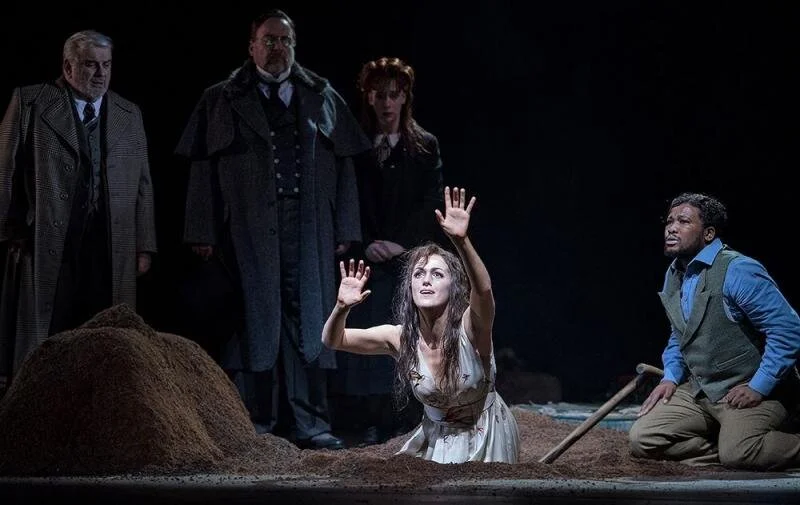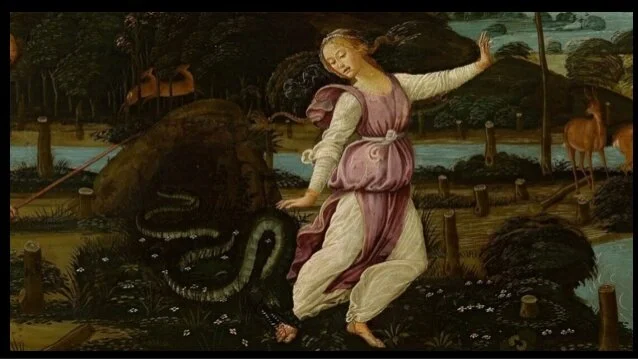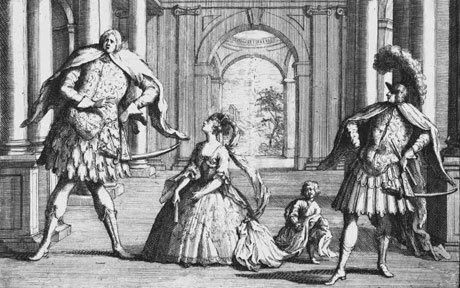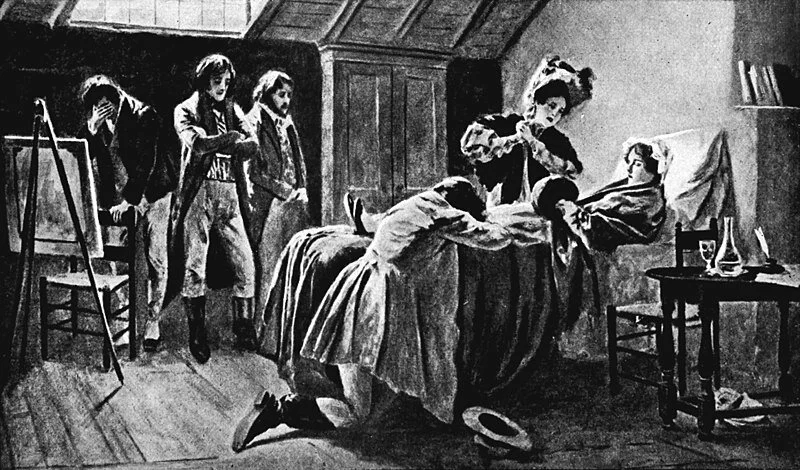So it Works
A Progressive Farewell to the Tragic Women of Opera
Once upon a time, Woman lived in a fantastical kingdom.
Woman, forlorn, lonely, and with an air of tragedy about her, meets heroic Man and they fall in love.
Some curse befalls Woman and she is fated to die [or suffer another form of doom].
Man finds his courage, confronts the curse and tries to save Woman.
He succeeds and Woman lives, now in perpetual existence of his shadow,
Or he fails and Woman dies, immortalized in tragedy.
You will have heard this story before.
If you’ve engaged in any literary work at all, you will have probably heard it too often. From Romeo and Juliet to The Fault in Our Stars, women’s stories have often revolved around forms of their tragic victimhood by (or beside) doom-underscored love.
Much of traditional opera, unfortunately, is no different.
From tragic Cio-cio San (Puccini's Madama Butterfly) who ends her life as she foregoes her estranged lover, to tragic Carmen (Bizet’s Carmen) who is murdered by her obsessive lover as she attempts to assert her freedom, opera is replete with female characters whose fates often end in death.
And there is little variance to the characteristics of the women protagonists in these stories, too.
Often, they’re either the Ingenue or the Spitfire; the naive innocent or the rebellious seductress. In serious opera (the traditionally big, grand ones from the 19th century that make up 80% of opera’s greatest hits-- the other 20% is Mozart), these two personalities rarely, (if at all) intersect, and good luck to you if you’re looking to find those who are neither.
But how did it come to be so?
Greek origins, and the travesti tradition
Opera, like the western art form of theatre, began in pious adoration of Greek dramas and mythologies. In ancient Greek culture, all of art was the province of men, and this tradition of exclusive public art-making carried over into most of European art, including opera.
However, exclusive as these origins were, early operas saw both men and women playing gendered roles interchangeably. Castrati (male singers castrated before puberty and therefore able to keep their higher voice registers) played male and female roles, and female singers with lower, fuller voices were employed likewise. The tradition is called travesti and while the castrati comprised the larger number of opera stars, many women performers enjoyed the freedom of playing diverse characters and stories. Granted, most of the stories still heavily portrayed men and women within the gender binary, but at least women didn’t just play damsels in distress. En travesti, women actually played heroes, too.
(History tidbit: Castration was declared illegal in 1861 but it’s practice did not officially end until 1903. The last opera with a written role for a castrato was premiered in 1824 and the last known castrato, Alessandro Moreschi retired in 1913.)
As castration became illegal, castrati roles started to be performed by women but shifting tastes in literature, acoustics, and aesthetics soon birthed a new opera hero, one that the male-dominated bourgeoisie saw closer to their image.
The (stifling) Romantic penchant and the rise of the tenor
The great French and Industrial Revolutions brought about new existential stories of morality in family, love, and freedom, and as literature formed a new ideal for the hero, opera also found a new ideal image and sound for its own “hero”. Travesti heroes were soon replaced by heroic tenors whose stories often heavily involved (doomed) heterosexual romantic relationships. With the rise of this new heroic ideal, women-protagonist roles were written to adhere more strongly towards the love-interest archetypes that we see even today.
Grand opera in the Romantic era (1800-1910, but mostly past 1830 for opera) that wanted more “truthful”/verismo stories on stage saw women depicted within the same societal capacities and expectations that they were relegated to in everyday life. Furthermore, the operas written and performed during this era were largely adaptations of melodramas in romantic literature; a genre of dramatic work characterized by excessive emotion, grandiose events, and oversimplified characters that are hard-lined into either good or evil.
In short, the new “hero” arguably created limited depictions of women that were further stifled by melodramatic penchant.
Women in opera today: a snapshot
Such is the (hyper-abridged) history of the current exclusive portrayal of women in opera, but where is this conversation today?
Like in most areas of social concern, gender parity is a fight still being waged in opera and, little by little, we are beginning to see how more gender perspectives are slowly finding ground.
Women comprise upwards of 70% of opera performers and 58.7% of audiences in North America. In Canada, 43% of executive and artistic leadership positions in opera companies are held by women, a rate that is projected to rise.
As the equitable voice begins to take ground, more and more operatic organizations will seriously have to consider telling stories representative of the greater half of their communities.
One such organization striving to contribute positively to the cause is Against the Grain Theatre (AtG).
With their digital offering of Sāvitri by Gustav Holst, AtG creators Miriam Khalil and Simran Claire present a rare opera story that has its heroine outwit Death rather than succumb to him. A rare opera story in which a woman celebrates the complexity of life rather than being the perpetual subject of torment.
Opera InReach had a chat with Miram, Simran, and Meher Pavri, who sings Sāvitri’s titular role, about what it was like to bring a different story to life.
A different story: Who is Sāvitri and what makes her good for opera?
Based on the ancient Hindu Legend from The Vana Parva (The Book of the Forest) of the Mahābhārata, Sāvitri tells the story of a powerful female princess, descended from the gods.
Miriam:
The story of Sāvitri is about a woman who has defied human limitations from the moment she was born. She was granted to her parents by the Goddess of the Sun, Sāvitri’s namesake, after eighteen years of waiting. When no one proposes to her when she comes of age, she goes out and looks for her own husband. When she is told he will die within a year’s time, she marries him anyway. When Death comes for her husband, she negotiates with Death and uses her intelligence to find a way to save her husband. If that is not operatic, I don’t know what is. The story is an epic tale and gives the opportunity to highlight and celebrate a culture so rich in history and tradition. It gives us a window into a beautiful world that we would not experience with many other operas.
Meher:
Sāvitri is strong, loving, intelligent, knows what she wants, and confident. She is a true heroine. I believe her story is effective on an operatic stage because there are so many parallels between the Mahabharata and opera as an art form. Telling a story from the Mahabharata, an ancient Hindu epic plus opera only makes sense. The emotions and mood of the story set to Holst's music are incredible. I also love that it was meant to be set outside and that is something we accomplished by making it into an operatic movie.
Simran:
I think she’s a very interesting character because she’s multi-dimensional; she’s allowed to have more than one feeling, which unfortunately is often not the case in the broader [operatic] canon. The grand nature of [her story] makes it super suited to opera, but I also think that her story in particular, of a woman empowered or a woman with agency, is especially welcome. I think it stands out in contrast. [About the Mahabharata] there’s this whole world that’s been built already that’s natural to go to because it’s an established canon of stories. It’s such an ancient work and such a timeless work that [making it an opera] just makes sense.
What aspects of this story have been most compelling for you? What has been most interesting to work on?
Miriam:
Diving deep into how to make a show like this, how to celebrate the story with respect and the proper weight that it deserves. The study of the individual characters and what they mean to one another in the original story and how we can best bring that out in our version of the opera.
Meher:
I just love how Sāvitri, with her wit and grace, convinces the God of Death, Yama, to give her her husband back. She is so pure, kind, and righteous that even Death cannot say no to her. You really are rooting for her the whole show. I am fascinated by a lot of tales in the Mahabharata and getting a chance to work on this was a dream to dive deep into something I'm already passionate about. I also loved every bit of the process, from recording with the incredible orchestra to acting for film.
Simran:
It’s been incredible to work on a story that comes from the same place that my ancestors came from… That relational aspect and learning about my own heritage [was important]. Of the story itself, I really like the character of Yama. I think that portraying Death in a way that isn’t inherently evil is something that isn’t typical. That Death is so open to conversation says a lot about him and I think it’s interesting from that perspective, especially in this western canon where we view death in a certain negative way.
How did you get to lead this project? Do you feel that the way you were engaged to lead this project was respectful and framed in such a way that it gave you agency over the vision that will create it?
Miriam:
I was asked by Joel Ivany (AtG’s Artistic Director) to have a look at the score to see if the story spoke to me. I was given full license to choose my creative team and to work with that team to make the best decisions that we could possibly make. It was a great learning experience for me. I loved my team and felt that we had a very respectful and open process. The hardest part though was not being able to have Simran Claire on-site with us. I felt we would have really benefited from her knowledge and perspective on site. We did a lot of work before the shoot, though, and had a very clear plan going in, which made for a very smooth process in the end.
Simran:
Miriam emailed me and she asked me if I wanted to help her with the creative. We met through Pacific Opera Victoria because she mentored me through Dadima. Collaborating with Miriam was never a prescriptive process. She asked for my opinion and valued it. It felt very collaborative. And AtG, in general, is a collaborative workplace. I felt respected and, in turn, it allowed me to focus on the work itself.
What has the process been like working with a team of women creators?
Meher:
What a dream! It's so rare that this happens, that it honestly made my heart sing, I was so happy. To work on a female character from two female director's points of view is something very special and they brought a unique perspective to everything. There were so many females in different roles on set and I felt so proud to be working with them all. To share a female perspective and views and also to have that kind of representation is everything. It also shows that more women can, should and will be doing more of this.
Simran:
It was amazing to be on a team that was majority women; I don’t think that I’ve been in a project like that, especially with women of color. From the beginning, the expectation was set that everyone could speak up if they had ideas and everybody’s opinions were taken into consideration. That constant invitation to speak created an environment wherein I felt valued; where my contributions were wanted and necessary. Through collaboration, the piece came into being.
In your experience of creating this show, what do you feel have been the greatest advantages of having the agency to tell this story?
Miriam:
The biggest advantages [are] that we were able to tell a story that was authentic and true to the original while paying the proper respect to the score and to the intentions of the composer. We were able to add to the story and tell a deeper and clearer narrative. We were also able to add the musical elements that brought greater authenticity to the nature of the piece.
Simran:
Having creative freedom is a huge advantage… Feeling able to express myself, feeling connected to the characters in a cultural sense. Having agency gave me more access to the characters, which informed my decisions as a director.
How has working on Savitri differed from working on other pieces that center women characters?
Miriam:
This piece centred around a female character that is rewarded for her strength, loyalty, unconditional love, holiness, and intelligence. I don’t know many stories like this. In opera female roles are often victims and when they are not, something tragic either happens to them so that we sympathize with them, or it’s a comedy. Sāvitri’s resilience and strength is one of very few exceptions in the female operatic canon.
Meher:
Let's face it, most female operatic characters are one, not the lead, two [created] from a male perspective, and three, they're rarely a woman of colour. Playing Sāvitri was so refreshing. I have never seen a character breakdown like the one she has ever before. She is brave, strong, unapologetic, pure, loving, intelligent, self-reliant, calm and rational in times of stress. I basically got to play a superhero and it was awesome.
Simran:
She doesn’t die (LOL). She’s portrayed in a really positive light and she has a sway on the narrative arc, on the story. She isn’t subjected to truly horrible things that are out of her control. She’s viewed as an equal by a literal god. She’s deified and elevated to a certain level while remaining a relatable character. She’s cool, what else can I say?
To learn more about Against The Grain’s production of Sāvitri and to get your tickets to watch, visit their website by clicking here.
Dreaming a reality
So it works.
An opera that isn’t about a woman’s tragedy works.
An opera whose creation is led by women works.
It shouldn’t have to be argued, but productions like AtG’s Sāvitri are a reminder that making space for different perspectives provides powerful ways in which stories can be told to affirm those that tell them and hear them.
Music, as a visceral but elusive artform, holds the power to shape us and socialize us. It can tell us about ourselves and can tell us of the worlds we wish to find ourselves in.
We invite you to find stories that resonate with you and allow you to see yourself. As you search, we offer you a few that we’ve found along the way.
(listed in no particular order)
Cecilia Livingston and Monica Pearce: Singing Only Softly (2019)
Inspired by the redacted entries from Anne Frank’s diaries, Singing Only Softly is a loving attempt to represent Anne in her own voice:
“...neither an innocent, nor a martyr, neither ingenue, nor symbol, she reveals herself in her writing to be a young woman of courage and substance confronting her circumstances with as much humour and grace as those circumstances could allow.”
This song-opera has been set both for film and live performance.
Paula Kimper and Wende Persons: Patience and Sarah (1998)
Following the novel of the same title by Isabel Miller, Patience and Sarah tells the love story of well-educated Patience and the poor farmer's daughter Sarah, and how they share their dreams of pioneering beyond their Connecticut hometown.
Dean Burry and Yvette Nolan: Shawnadithit (2019)
Commissioned by Toronto company Tapestry Opera, Shawnadithit tells an essential story about the legacy of Shanawdithit, a young Indigenous woman who helped document the history of her people: the Beothuk Indigenous communities of what’s now Newfoundland and Labrador.
Jake Heggie and Terrence McNally: Dead Man Walking (2000)
Based on the narrative book by Sister Helen Prejean, Dead Man Walking narrates the journey and compassion of a Louisiana nun who becomes the spiritual advisor to a convicted murderer on Angola’s death row.
Richard Danielpour and Toni Morrison: Margaret Garner (2005)
With its libretto penned by Nobel-prize-winning author, Toni Morrison, Margaret Garner follows the painful fight for freedom of the historical American figure of the same name. Her story advanced the rift between the abolitionists and the defenders of slavery, a rift that would help lead to the Civil War.
Missy Mazzoli and Royce Vavrek: Song From the Uproar — The Lives and Deaths of Isabelle Eberhardt (2012)
Mazzoli’s Song From the Uproar was created after the journals of Isabelle Eberhardt, an explorer, and writer who relentlessly defied the cultural expectations of her time. It is an opera in one act sung entirely by one singer.
Alice Ho and Majorie Chan: The Lesson of Da Ji (2013)
The Lesson of Da Ji blends the European masque tradition with classical Peking opera to tell a vibrant and beautiful story, an invented tale of forbidden love based on the historic character of Da Ji, a famous concubine of the Shang Dynasty.
Renee Fajardo (she/her)
Ontario Provincial Coordinator, Opera InReach








